Figure 1.
UNC9975 and UNC9994 reduce hyperlocomotion in the open field in NR1-KD mice. Baseline activities of WT and NR1-KD animals were monitored over 30 min, they were treated (arrow) with vehicle (Veh) or different doses of UNC9975, UNC9994, or haloperidol, and were returned immediately to the open field for 90 min. (a, b) Effects of UNC9975 on WT and NR1-KD locomotor activity. For baseline activity, RMANOVA found the within-subjects time-by-genotype interaction (F(5, 265)=4.67, p<0.001) and the between-subjects genotype effect (F(1, 53)=34.08, p<0.001) to be significant. Following UNC9975 injection, RMANOVA revealed the within-subjects time effect to be significant (F(17, 901)=3.40, p<0.001). (c) Cumulative locomotor activities of both genotypes following injection of Veh or UNC9975 (31–120 min). A two-way ANOVA observed the effects of genotype (F(1, 53)=46.47, p<0.001) and treatment (F(2, 53)=4.52, p=0.015), and the genotype-by-treatment interaction to be significant (F(2, 53)=4.26, p=0.019). (d, e) Effects of UNC9994 on WT and NR1-KD locomotion. For baseline activity RMANOVA reported a within-subjects effect of time (F(5, 265)=12.32, p<0.001) and the time-by-genotype interaction (F(5, 265)=3.34, p=0.006) to be significant. The between-subjects genotype effect (F(1, 53)=36.81, p<0.001) was also significant. Following UNC9994 injection, RMANOVA noted a significant within-subjects effect of time (F(17, 901)=3.47, p<0.001), and significant time-by-genotype (F(17, 901)=1.96, p=0.011), time-by-treatment (F(34, 901)=2.25, p<0.001), and time-by-genotype-by-treatment interactions (F(34, 901)=1.52, p=0.030). (f) Cumulative distance traveled by both genotypes following injection of Veh or UNC9994 (31–120 min). A two-way ANOVA observed significant effects of genotype (F(1, 53)=64.38 p<0.001) and treatment (F(2, 53)=8.52, p=0.001); the genotype-by-treatment interaction (F(2, 53)=6.66, p=0.003) was also significant. (g, h) Effects of haloperidol on WT and NR1-KD locomotion. The RMANOVA for baseline activity observed significant within-subject effects of time (F(5, 295)=13.927, p<0.001), and a significant time-by-genotype interaction (F(5, 295)=5.136, p<0.001). Following haloperidol treatment, RAMANOVA revealed a significant effect of time (F(17, 1003)=6.496, p<0.001), and significant time-by-genotype (F(17, 1003)=1.904, p<0.015) and time-by-treatment interactions (F(51, 1003)=1.526, p<0.011). Whereas the within-subjects effects for the time-by-genotype-by-treatment interaction was not significant, the cubic function detected a significant three-way interaction (F(3, 59)=2.946, p<0.040). (i) Cumulative locomotor activities of WT and NR1-KD mice following injection of Veh or haloperidol (31–120 min). A two-way ANOVA found significant effects of genotype (F(1, 45)=51.299, p=0.001), treatment (F(2, 45)=24.127, p=0.001), and a significant genotype-by-treatment interaction (F(2, 45)=19.096, p=0.001). N=8–11 mice for UNC9975, N=9–11 mice for UNC9994, and N=8–9 mice for haloperidol per genotype per treatment. The data are presented as mean±SEM; *p<0.05, WT vs NR1-KD for the same dose; #p<0.05, within-genotype comparison vs the Veh; +p<0.05 within-genotype 0.5 compared with 1 mg/kg haloperidol.

